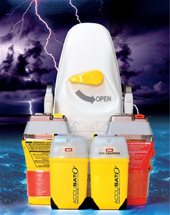The COSPAS-SARSAT rescue transmitters, or more briefly the beacons, use the system maintained by the International Organization COSPAS-SARSAT to transmit the position in case of real emergency.
The transmitted signal is captured by the COSPAS/SARSAT satellites, which locate the position of the transmitter and send the programmed data inside the rescue coordination centre.
They transmit on the 406 MHz frequency and digitally send the identification data stored inside. Many of them also transmit in analogue on the 121.5 MHz frequency which, being radiogoniometric, helps in the approach of rescuers.
The maximum error in the localization is 5 km, while for models equipped with GPS this is reduced to 100 m., which is why many recommend the purchase of the latest generation models equipped with GPS.
